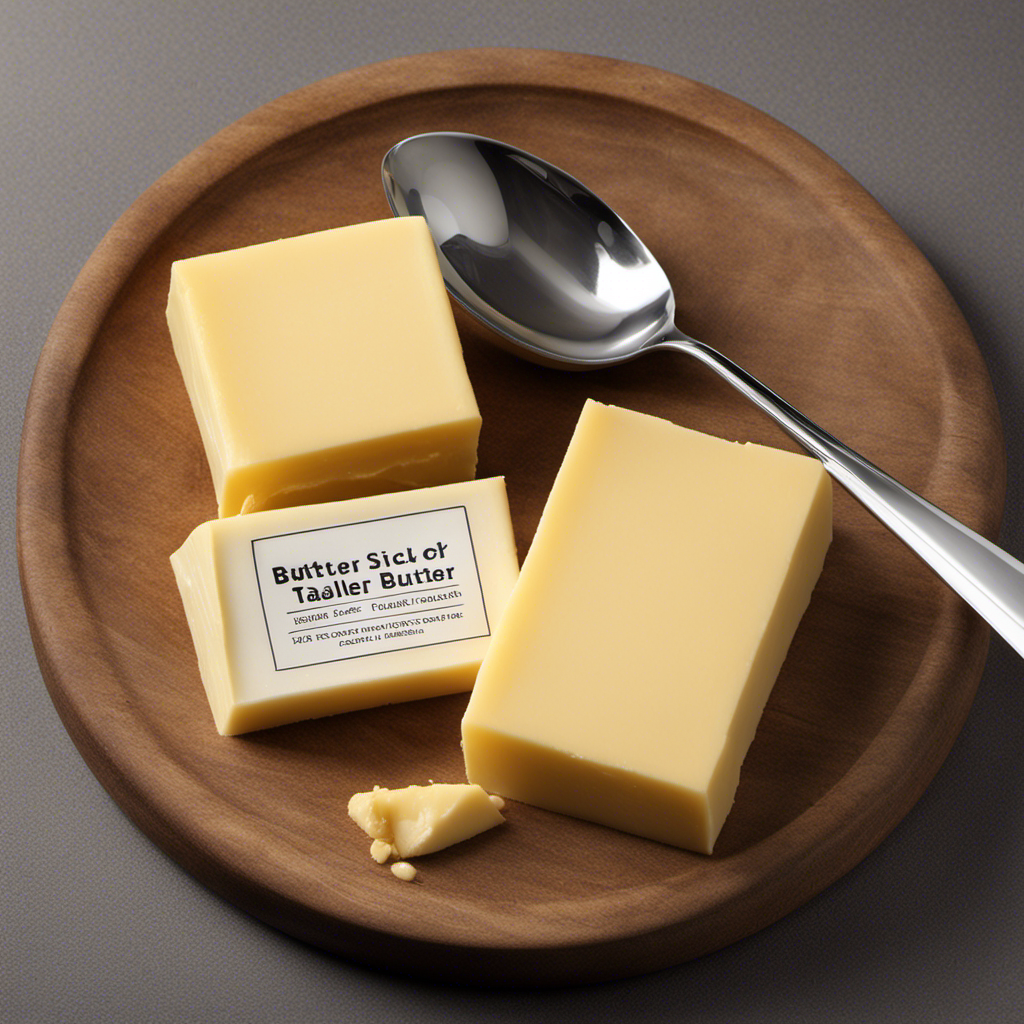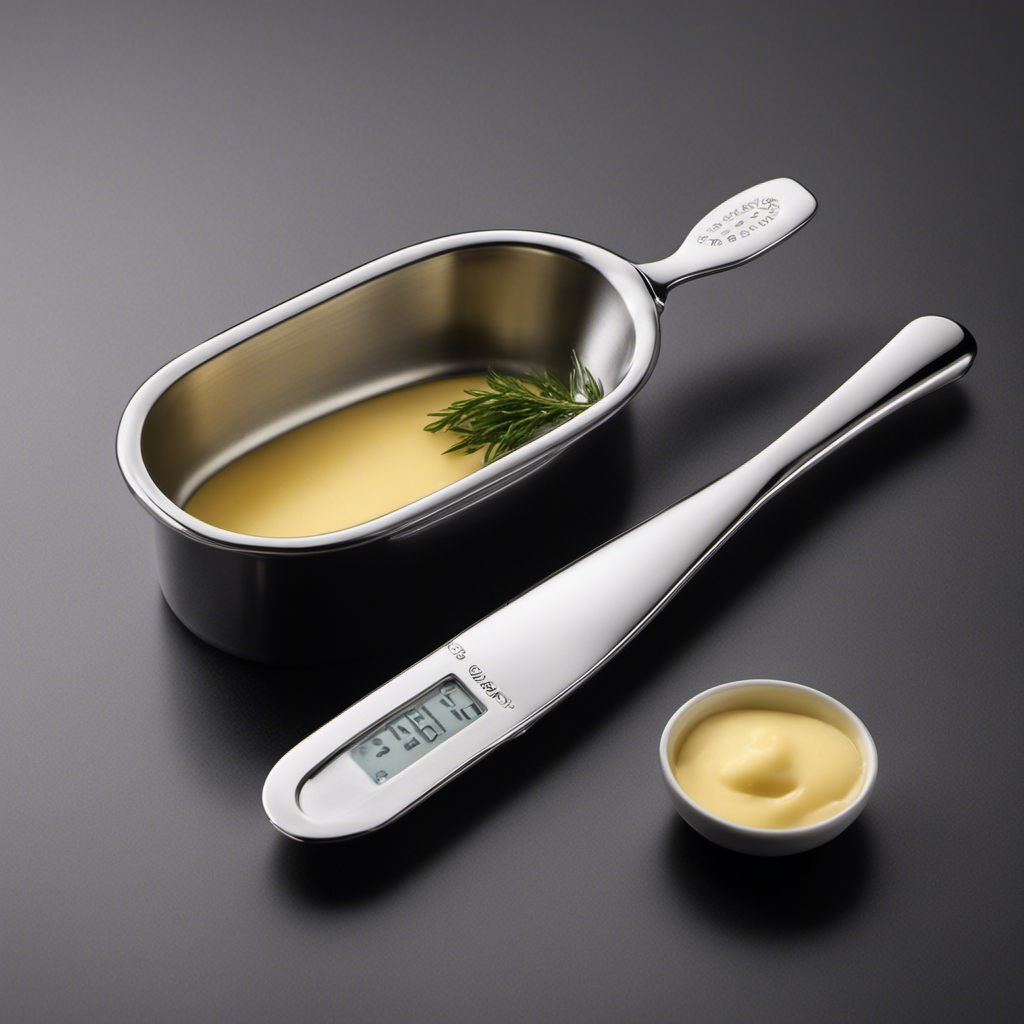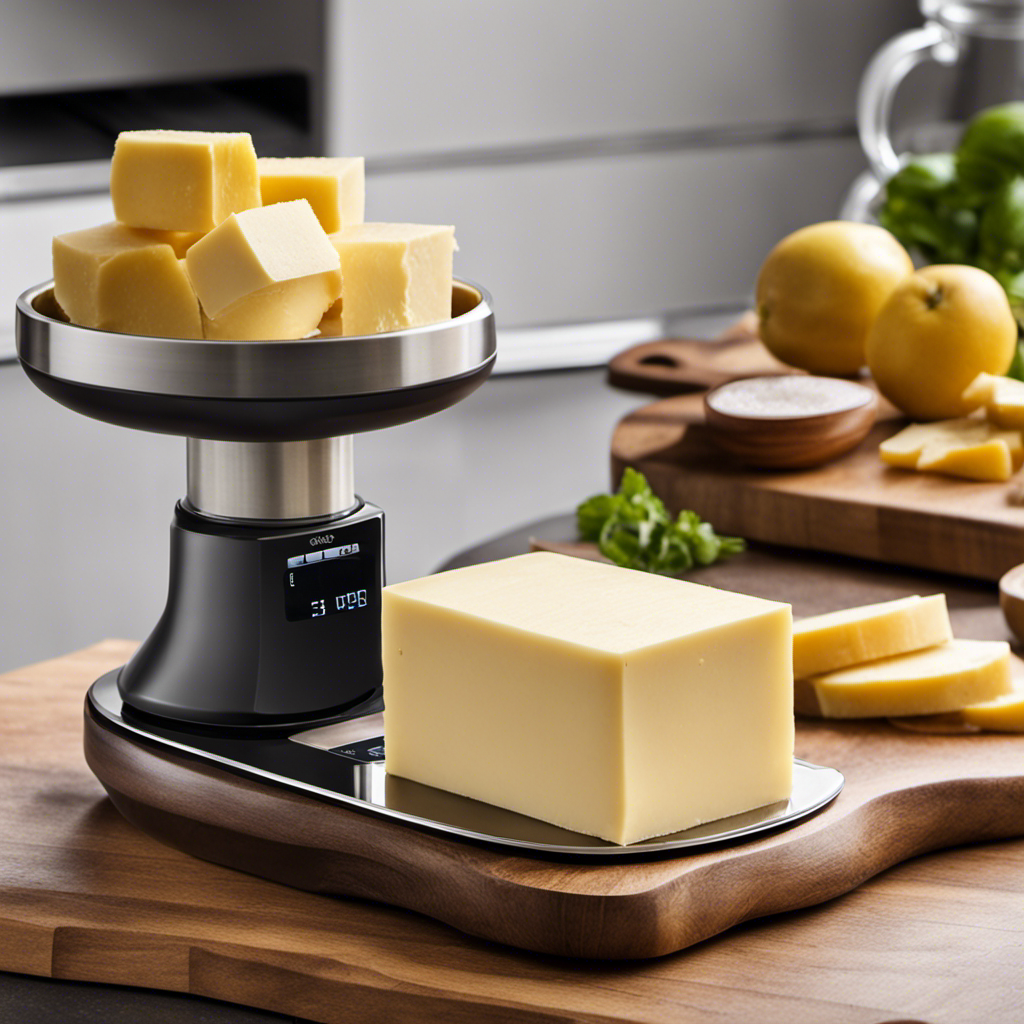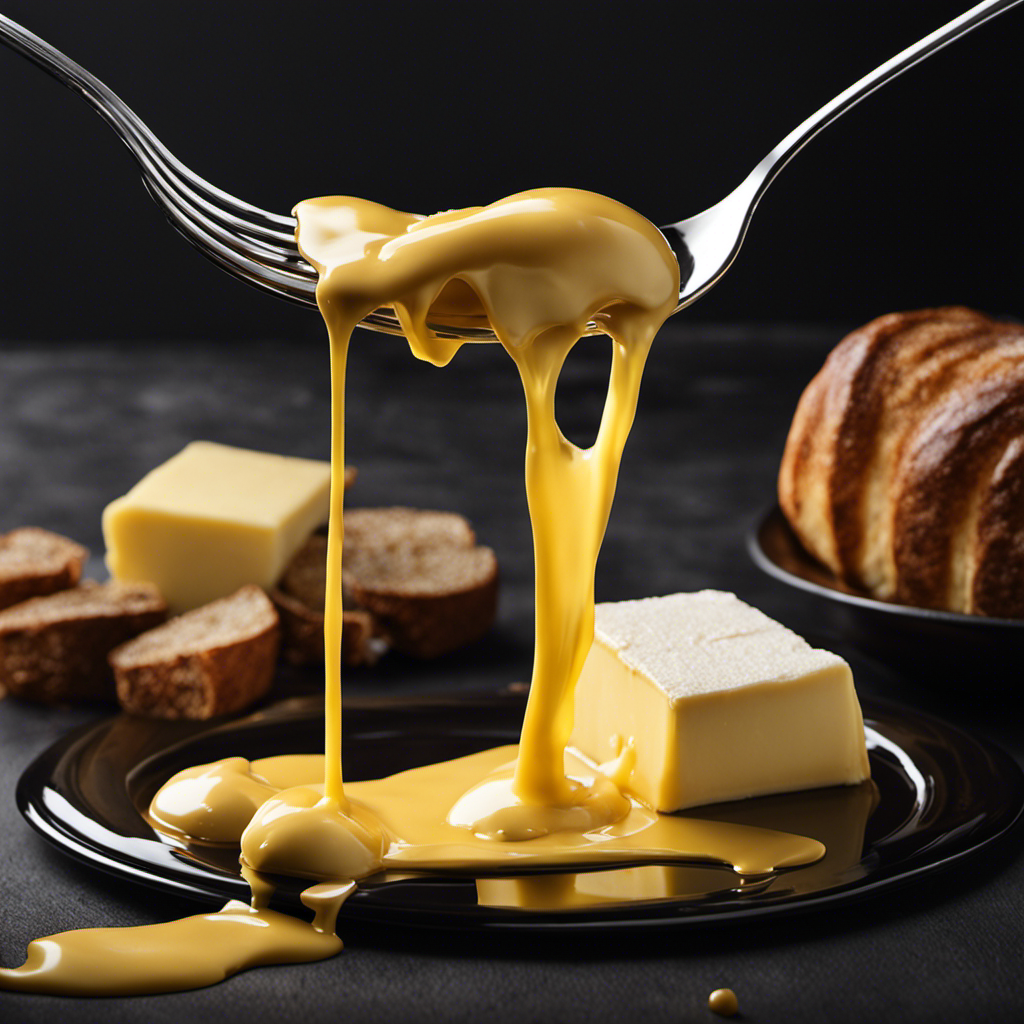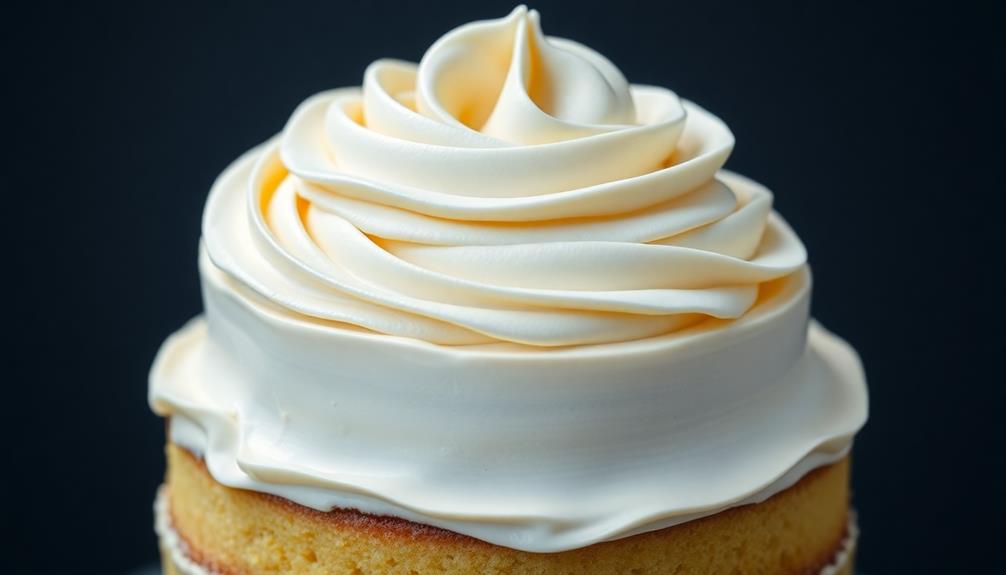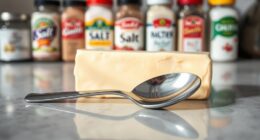I’ve often pondered the number of tablespoons contained within a single stick of butter. This inquiry frequently arises during my baking endeavors. Consequently, I chose to undertake some investigation to resolve this question definitively.
In this article, I’ll break down the measurements and ratios, as well as provide a handy conversion chart. By the end, you’ll be equipped with all the knowledge you need to confidently measure butter in tablespoons for your recipes.
Let’s dive in!
Key Takeaways
- One stick of butter is equal to 8 tablespoons.
- Understanding butter measurements is important for accurate baking and cooking.
- Butter sticks can be substituted with margarine or coconut oil.
- Converting butter measurements can be done using a conversion chart or a kitchen scale for precise measurements.
Butter Measurements
You’ll be happy to know that one stick of butter is equal to 8 tablespoons.
When it comes to butter measurement equivalents, it’s important to understand the conversions. If you ever come across a recipe that calls for cups of butter, you can easily convert it from tablespoons.
One stick of butter is also equal to half a cup or 1/4 pound. This means that if a recipe requires 1 cup of butter, you will need 2 sticks. Similarly, if a recipe calls for 1/2 cup of butter, you can simply use 1 stick.
Understanding these conversions can be helpful in ensuring the accuracy of your baking or cooking.
Understanding Butter Sticks
To understand the measurement of a stick of butter, it’s helpful to know that it is equivalent to 8 tablespoons.
However, there are alternatives to using butter sticks in recipes. Margarine, for example, can be used as a substitute for butter sticks. It has a similar texture and taste, making it a suitable option for those who are looking for a dairy-free alternative.
Another alternative is coconut oil, which can be used in baking recipes that require butter sticks. It adds a subtle coconut flavor and provides a healthier option since it contains beneficial fatty acids.
Using butter sticks has its own benefits too. They are pre-measured, making it easier to follow a recipe accurately. They also have a consistent texture, ensuring that your baked goods turn out perfectly every time.
Converting Butter Sticks to Tablespoons
Understanding the conversion from butter sticks to tablespoons can be helpful when following recipes.
To convert butter stick measurements to tablespoons, it’s important to know that one stick of butter is equal to 8 tablespoons. This conversion is consistent across most recipes and is a widely accepted standard.
However, it’s worth noting that butter sticks can vary in size depending on the country or brand.
In addition to tablespoons, butter can also be measured in cups or grams. One stick of butter is equivalent to 1/2 cup or approximately 113 grams.
Converting butter measurements to grams can be especially useful when following recipes that require precise measurements.
Butter Stick to Tablespoon Ratio
The ratio of tablespoons to a stick of butter is consistent across most recipes. It’s important to know the butter stick equivalents and butter conversion calculations to ensure accurate measurements in cooking and baking. Here is a table that provides a quick reference for converting butter sticks to tablespoons:
| Butter Sticks | Tablespoons |
|---|---|
| 1 Stick | 8 |
| 2 Sticks | 16 |
| 3 Sticks | 24 |
| 4 Sticks | 32 |
How to Measure Butter Sticks
When measuring, remember that you can easily determine the number of tablespoons needed for a specific amount of butter by using the provided table.
However, if you don’t have access to a table or prefer other measuring alternatives, there are common baking measurements you can use to estimate the amount of butter needed. For example, one stick of butter is equal to 8 tablespoons or 1/2 cup. This measurement is widely used in baking recipes and can be easily converted to other units if necessary.
It is important to keep in mind that accuracy is crucial when measuring ingredients, especially in baking. Now that we know the tablespoon equivalent of one stick of butter, let’s move on to the subsequent section to explore other useful conversions and tips for measuring butter.
Tablespoon Equivalent of One Stick of Butter
When it comes to baking with butter, understanding the measurement conversions is crucial.
One key point to consider is the conversion between sticks of butter and tablespoons. Knowing how many tablespoons are in one stick of butter can make a significant difference in your recipes.
Additionally, it is important to understand the difference between using sticks versus tablespoons of butter in baking, as it can affect the texture and consistency of your baked goods.
Butter Measurement Conversion
To convert the measurement of one stick of butter to tablespoons, you’ll need to know that it equals 8 tablespoons. This is a useful measurement to know when converting butter for recipes.
Here are some key points to consider:
-
Butter Measurement Equivalents:
-
1 stick of butter = 8 tablespoons
-
1/2 stick of butter = 4 tablespoons
-
1/4 stick of butter = 2 tablespoons
-
Converting Butter for Recipes:
-
If a recipe calls for 1/2 cup of butter, you would need 1 stick of butter, which is equivalent to 8 tablespoons.
-
If a recipe calls for 1/4 cup of butter, you would need 1/2 stick of butter, which is equivalent to 4 tablespoons.
Knowing these butter measurement equivalents will ensure accurate measurements in your recipes. It’s always helpful to have this conversion knowledge on hand for a smooth cooking experience.
Stick Vs. Tablespoons
The conversion of measurements between sticks and tablespoons is important for accurate recipe preparation. When it comes to butter, understanding the conversion from sticks to tablespoons can make a significant difference in your baking.
One stick of butter is equivalent to 8 tablespoons or 1/2 cup. This conversion allows for precise measurements when adding butter to your recipes.
Measuring butter in tablespoons has its benefits, as it provides a more granular control over the amount of butter you add. This can be particularly useful when you need to adjust the fat content or texture of your baked goods. By measuring butter in tablespoons, you can easily add or subtract small amounts to achieve the desired result.
Now that we have covered the stick vs. tablespoons conversion, let’s move on to exploring the various ways you can use butter in your baking.
Baking With Butter
When it comes to baking, butter is a crucial ingredient that adds flavor and moisture to our favorite treats. However, measuring butter accurately can be a challenge.
To ensure precision in your recipes, it’s important to measure butter correctly. One stick of butter is equivalent to 8 tablespoons or 1/2 cup.
But what if you run out of butter or prefer a different option? Here are some butter substitution options to consider:
-
Margarine: Margarine can be used as a substitute for butter in most baking recipes. It has a similar texture and flavor, but be sure to use a margarine with a high fat content to achieve the best results.
-
Oil: In some recipes, you can replace butter with an equal amount of oil. However, keep in mind that oil may alter the texture and flavor of your baked goods.
Butter Stick Vs. Tablespoon Conversion
There’s a difference between a stick of butter and a tablespoon when it comes to measuring. In terms of butter stick measurements, one stick typically equals 1/2 cup or 8 tablespoons.
This is important to know when following a recipe that calls for a specific amount of butter in cups or tablespoons. To convert butter stick to cup measurements, you’ll need to divide the number of sticks by two. For example, if a recipe calls for 1 cup of butter, you would need to use 2 sticks.
On the other hand, if you’re calculating butter quantity in tablespoons, you’ll need to multiply the number of sticks by 8. This means that one stick of butter is equivalent to 8 tablespoons.
Understanding these conversions will ensure accurate measurements in your baking endeavors.
Calculating Butter Quantity in Tablespoons
To calculate how much butter you need in tablespoons, simply multiply the number of sticks by 8. It’s a simple and straightforward conversion that is commonly used in baking and cooking.
When it comes to butter measuring techniques, it’s important to have a clear understanding of butter measurement equivalents. Here are two sub-lists to help you navigate this topic:
-
Butter Measurement Equivalents:
-
1 stick of butter = 8 tablespoons
-
1/2 stick of butter = 4 tablespoons
-
1/4 stick of butter = 2 tablespoons
-
Practical Tips:
-
If you don’t have a stick of butter, you can use a tablespoon to measure the desired quantity.
-
Remember to level off the tablespoon when measuring butter to ensure accuracy.
Now that you know how to calculate butter quantity in tablespoons, let’s explore the measurement for one stick of butter in detail.
Tablespoon Measurement for One Stick of Butter
When it comes to measuring butter, one key point to consider is the stick-to-tablespoon conversion. Knowing how many tablespoons are in one stick of butter is crucial for accurate measurements in recipes.
However, it is important to note that the accuracy of butter measurements can vary depending on factors such as temperature and density. In some cases, alternative butter measurements, such as using a kitchen scale or pre-measured butter sticks, may be more precise and convenient options.
Stick-To-Tablespoon Conversion
You can easily convert one stick of butter to tablespoons by multiplying it by 8. This is a simple and quick way to determine the measurement when using recipes that require tablespoons of butter.
Here are some additional details to help you understand stick-to-tablespoon conversion and improve your butter measuring techniques:
- When using sticks of butter, it’s important to note that they typically come in a standard size of 4 ounces or 113 grams.
- Each stick of butter is equivalent to 8 tablespoons, making it convenient to measure out the required amount for your recipe.
- For more precise measurements, you can use a kitchen scale to weigh the butter accurately.
- If you don’t have a scale, you can also use the measurement markings on the butter wrapper to estimate the required amount.
Understanding stick-to-tablespoon conversion and exploring different butter measuring techniques will ensure that you use the right amount of butter in your recipes.
Now, let’s delve into the next section about butter measurement accuracy.
Butter Measurement Accuracy
Using a kitchen scale is a precise method to accurately measure the amount of butter needed for your recipe. Measuring butter by weight ensures that you have the exact amount required, resulting in consistent and reliable results in your baking or cooking. A kitchen scale allows you to measure butter in grams or ounces, providing a more accurate measurement than using volume-based tools like tablespoons. This level of precision is especially important when it comes to delicate recipes where the right amount of butter can make a significant difference.
Incorporating butter measuring tools like a kitchen scale into your culinary process will help you achieve the perfect balance of flavors and textures in your dishes.
Alternative Butter Measurements
To achieve precise measurements for butter in your recipes, consider utilizing alternative methods such as weight-based measurements or volume-based conversions. These alternative butter measurements can help ensure accuracy and consistency in your cooking and baking.
Here are two sub-lists that provide more information on the different options available:
-
Weight-based measurements:
-
Weighing butter using a kitchen scale allows for the most accurate measurement. Simply place a bowl on the scale, zero it out, and then add your desired amount of butter.
-
Converting butter measurements:
-
1 stick of butter is equal to 4 ounces or 113 grams.
-
If a recipe calls for tablespoons of butter, you can use a conversion chart to determine the equivalent amount of butter in sticks or ounces.
Butter Stick to Tablespoon Conversion Chart
Need to know how many tablespoons are in one stick of butter? Here’s a helpful conversion chart for butter sticks to tablespoons.
| Butter Sticks | Tablespoons |
|---|---|
| 1 Stick | 8 Tablespoons |
| 2 Sticks | 16 Tablespoons |
| 3 Sticks | 24 Tablespoons |
| 4 Sticks | 32 Tablespoons |
This conversion chart is essential when following recipes that require butter measurements in tablespoons instead of sticks. It saves time and ensures accurate measurements. By knowing that one stick of butter is equivalent to 8 tablespoons, you can easily adjust your recipe accordingly. Whether you need to melt, soften, or cut butter, this conversion chart simplifies the process. Remember, butter measurements can vary depending on the brand and country, so it’s always a good idea to check the packaging for specific measurements. Happy baking!
Handy Tips for Measuring Butter in Tablespoons
When it comes to measuring butter in tablespoons, accuracy is key. Knowing the conversion from sticks to tablespoons can simplify the process and ensure precise measurements.
In this discussion, we will explore the butter tablespoon conversion chart, provide tips for accurate butter measurements, and discuss how to simplify the process of measuring butter.
Butter Tablespoon Conversion
There’s no way to convert a stick of butter into tablespoons. However, knowing the equivalent measurements can be incredibly helpful when it comes to cooking and baking. Here are some key points to consider when it comes to butter tablespoon equivalents:
- 1 stick of butter is equal to 8 tablespoons or 1/2 cup.
- This standard conversion makes it easier to measure butter accurately in recipes.
- Measuring butter in tablespoons allows for more precise control over the amount of fat added to a dish.
By using tablespoons as a unit of measurement for butter, you can easily adjust the amount according to your needs. It’s especially useful when you only need a small amount of butter or when you want to reduce the fat content in a recipe.
Now that we understand the basics of butter tablespoon equivalents, let’s dive into the next section about accurate butter measurements.
Accurate Butter Measurements
To accurately measure butter, you should rely on a kitchen scale for precise measurements. Using a kitchen scale ensures accuracy and consistency in your baking or cooking. Many recipes call for butter to be measured in tablespoons or cups, but alternative measurements can lead to inconsistent results. Estimating by eye or using a tablespoon may not provide the exact weight of butter needed. A kitchen scale allows you to measure the exact weight of butter required, which is especially important in recipes that require precise ratios of ingredients. To measure butter with a kitchen scale, place a container on the scale, reset it to zero, and then add the desired amount of butter. This method provides the most accurate measurement and ensures your recipes turn out just right.
Simplify Butter Measuring
Using a kitchen scale simplifies the process of measuring butter accurately. It not only saves time but also ensures consistent results in your recipes. Here are two reasons why using a kitchen scale can simplify butter measuring:
-
Precision: A kitchen scale allows you to measure butter in grams or ounces, providing precise measurements for your recipes. This eliminates the need for complicated conversions and ensures that you’re using the right amount of butter every time.
-
Easy conversions: With a kitchen scale, you can easily convert between different measurements of butter. For example, if a recipe calls for 1 stick of butter, which is equivalent to 8 tablespoons, you can weigh the stick and then measure out the corresponding amount in tablespoons using the scale.
Frequently Asked Questions
Can I Use Margarine Instead of Butter in the Same Measurements?
Yes, you can use margarine instead of butter in the same measurements. However, keep in mind that margarine may affect the taste and texture of the recipe. Additionally, consider the health benefits of butter vs margarine.
How Many Tablespoons Are in a Half Stick of Butter?
To convert a half stick of butter to tablespoons, simply divide it by 2. Therefore, a half stick of butter is equivalent to 4 tablespoons.
Is It Possible to Measure Butter in Grams Instead of Tablespoons?
Measuring butter in grams: is it more accurate than using tablespoons? Converting butter measurements from tablespoons to grams: a helpful guide. In my experience, measuring butter in grams provides a more precise and consistent result compared to using tablespoons.
Can I Use a Kitchen Scale to Measure Butter Instead of Using Tablespoons?
I can measure butter in grams using a kitchen scale. It’s an alternative to using tablespoons. This method is precise and technical, giving accurate measurements for recipes.
Are There Any Substitutes for Butter When Measuring in Tablespoons?
There are several substitute options for butter when measuring in tablespoons. Some vegan alternatives include coconut oil, olive oil, or mashed avocado. These can provide a similar texture and flavor in recipes.
Conclusion
As I carefully measured out the sticks of butter, I couldn’t help but marvel at the simple beauty of this culinary measurement. Just like a stick that holds together, one stick of butter holds within it the power to transform any dish into a masterpiece.
And with a simple conversion, we can unlock its true potential. From the golden ratio of one stick to eight tablespoons, to the handy conversion chart that ensures precision in every tablespoon, measuring butter has never been easier.
So go forth, armed with this knowledge, and let the magic of butter unfold in your kitchen.
